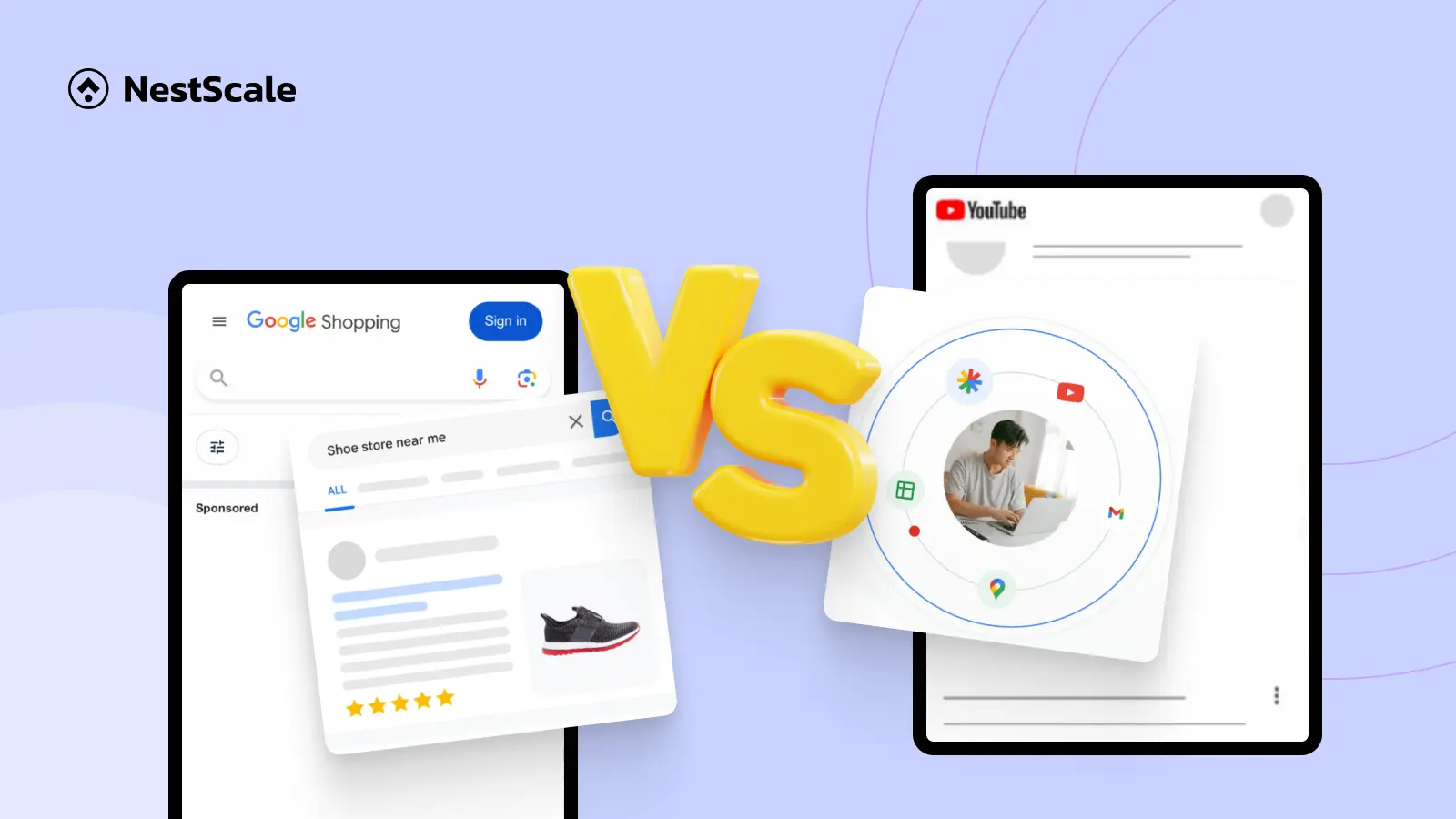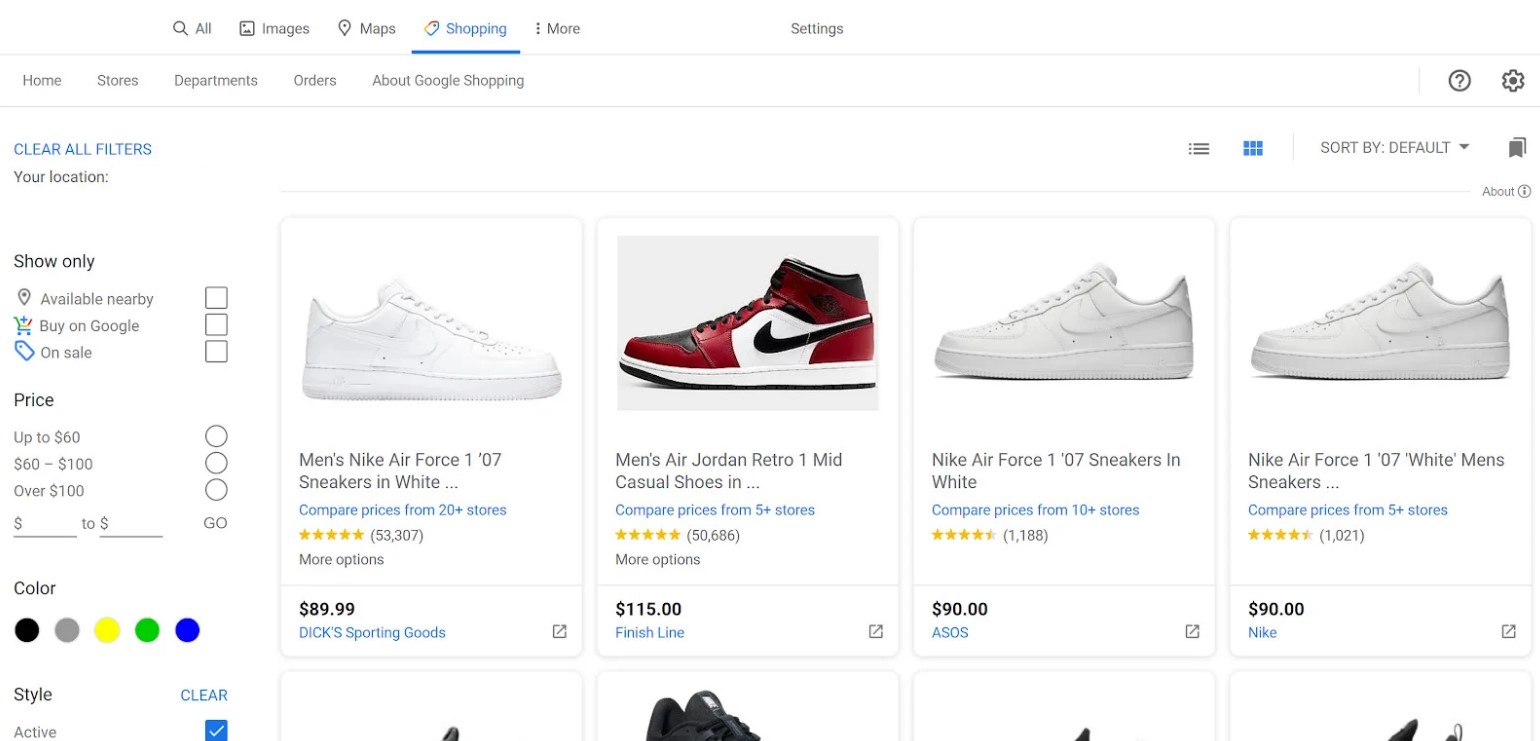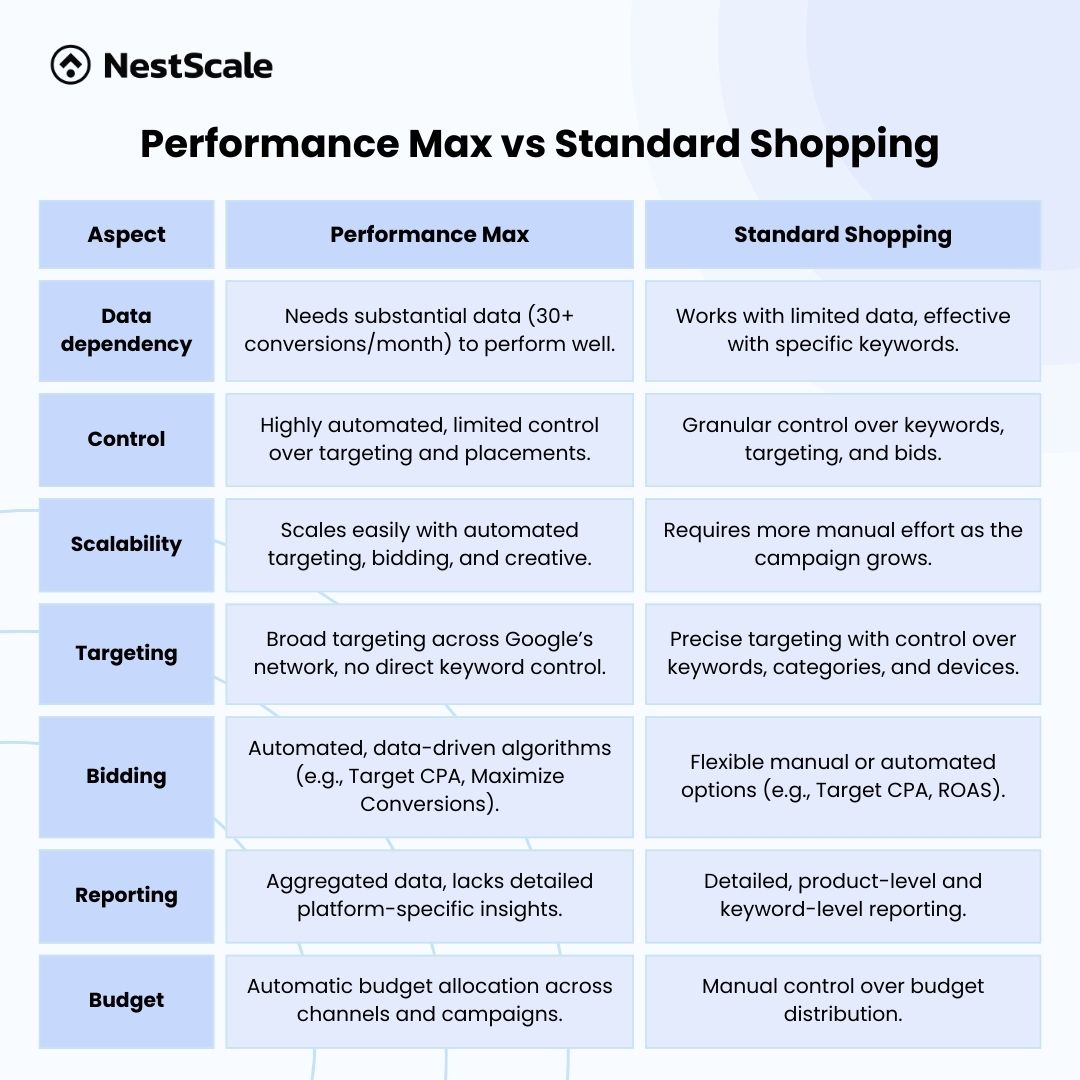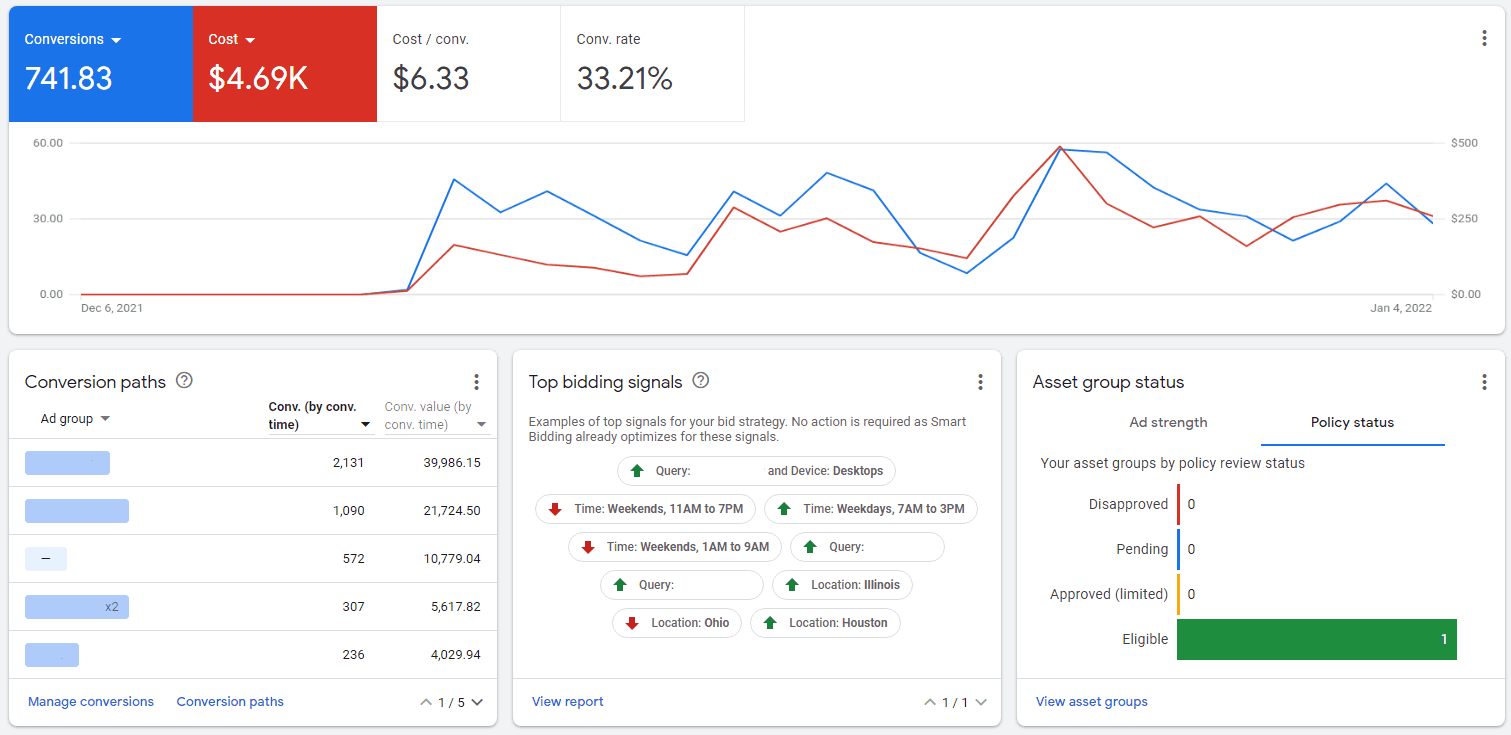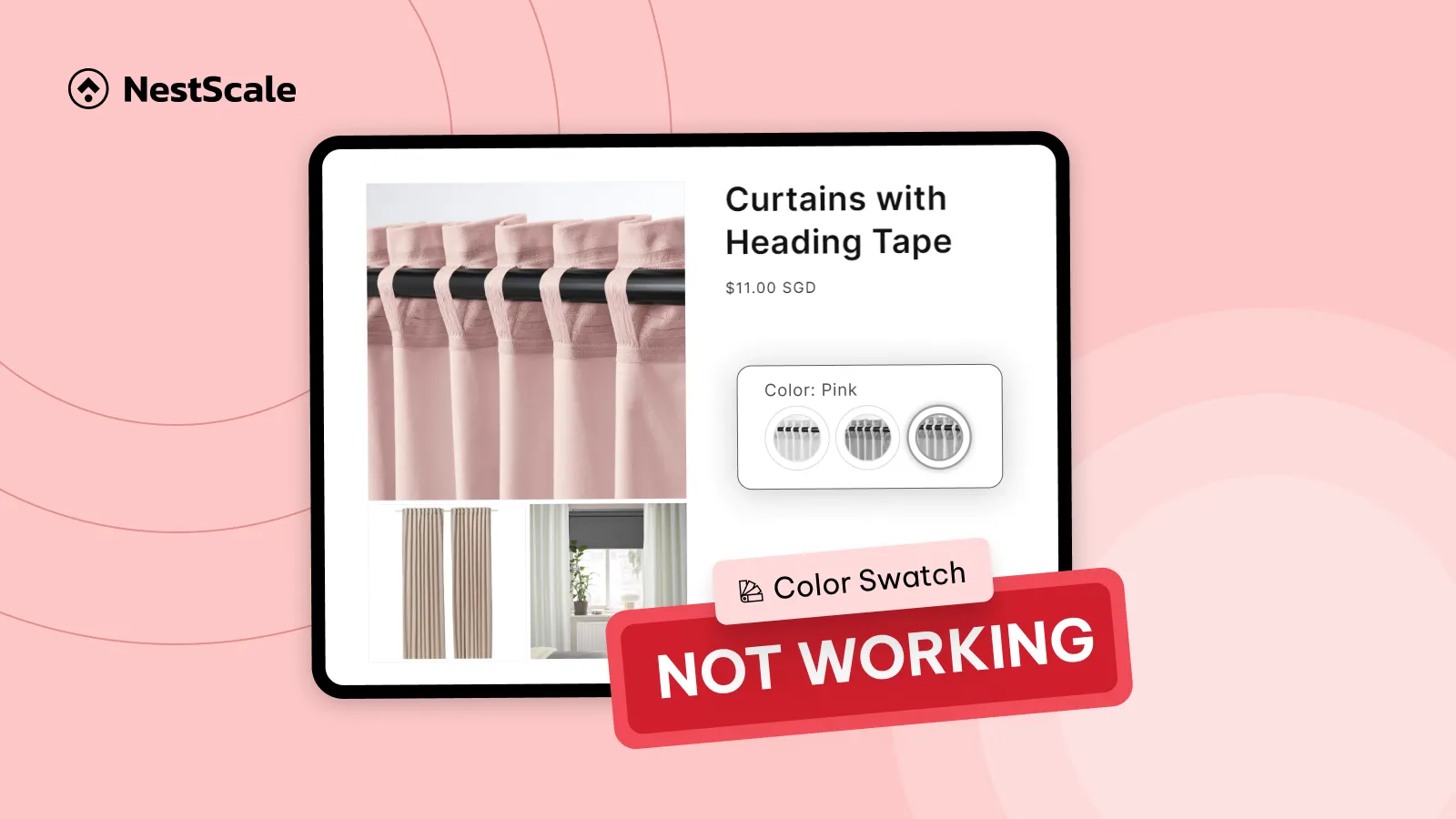When we discuss boosting online sales, the debate of Performance Max vs Standard Shopping campaigns often comes down to which approach delivers better results, like cost per acquisition (CPA) and revenue. Both campaigns share the same goal of driving sales, but they use different strategies and tools to get there.
And while Google’s algorithms evolve, businesses may want to know which campaign performs better and works out for their business. So, we write this blog to break down the key differences and strengths of these campaigns to help you make the right decision for your own growth strategy.
An overview of Performance Max vs Standard Shopping campaign
Before we discuss the differences between these campaigns, let’s get to know them and see how they work.
Performance Max
Performance Max campaigns employ Google’s AI to optimize your ads across various Google networks like Search, Display, YouTube, Discovery, and Gmail, all within a single campaign.
You start by setting clear goals, such as driving sales or generating leads, and then provide Google with assets like images, text, and videos. From there, Google’s AI takes over, determining the best placements, formats, and combinations to reach your target audience effectively.
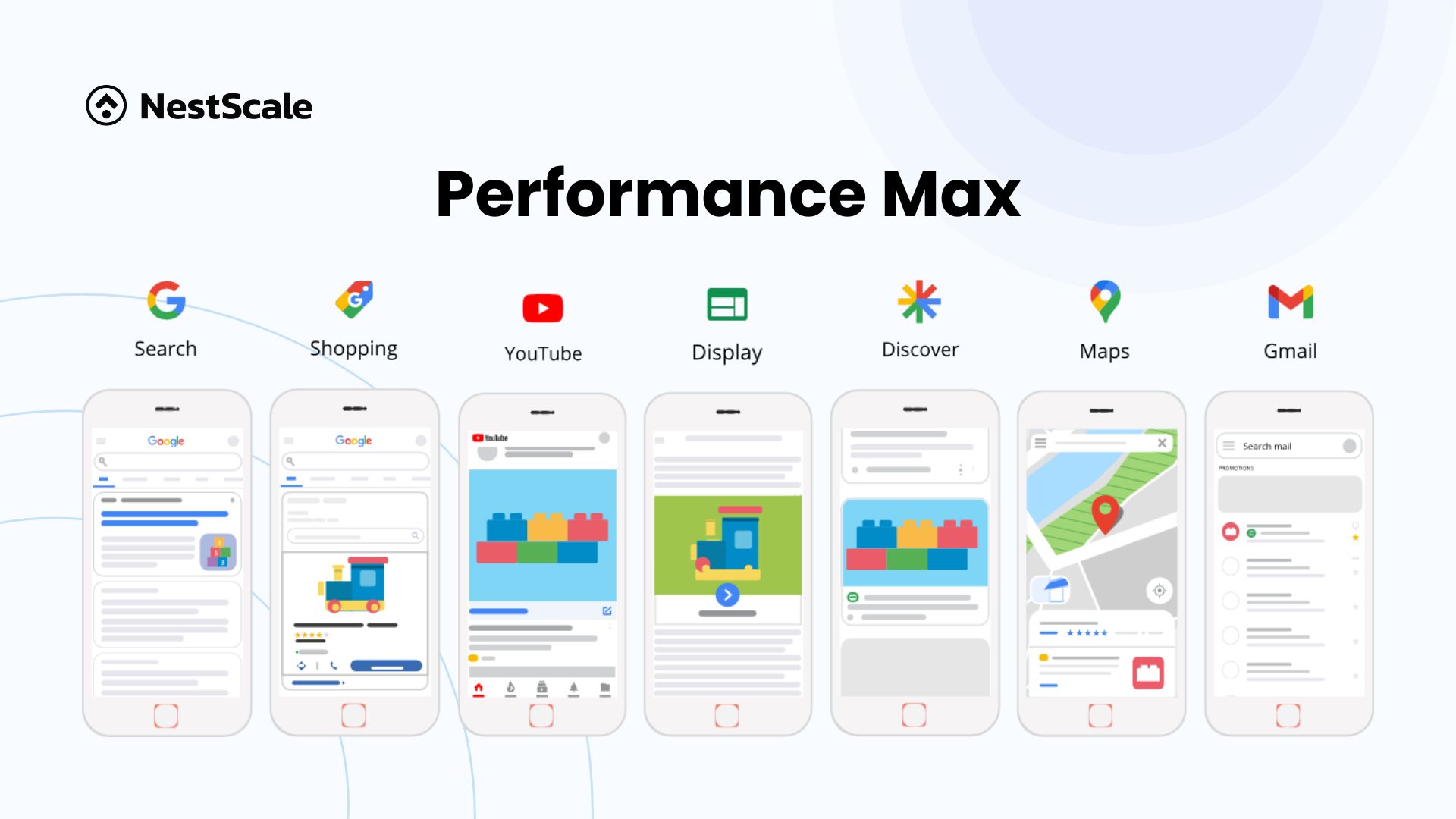
While this approach reduces the need for manual control over targeting and bidding, it allows the algorithm to make real-time decisions. Thereby, it aims to maximize performance based on your campaign objectives.
| Pros | Cons |
| – Broader reach across Search, Display, YouTube, Discovery, and Gmail. – AI-driven optimization reduces manual effort. – Supports multiple formats (text, image, video). – Continuous AI adjustments for performance. | – Limited control over settings. – Lack transparency in how decisions are made. – AI learning takes time to optimize. |
Standard Shopping
Standard Shopping campaigns are designed to target users who are actively looking for products on Google Shopping.
The process often begins by creating a product feed, which includes key information such as titles, descriptions, and prices. Once the feed is set up, you configure the campaign with appropriate keywords and targeting options. Google then automatically showcases your products in Shopping results whenever people make relevant searches.
In contrast to Performance Max, Standard Shopping gives you greater control, enabling manual adjustments for targeting, bidding, and ad extensions.
| Pros | Cons |
| – Offers more control over targeting, bidding, and ad settings. – Focused mainly on Google Search and Shopping ads, making management straightforward. – Clear insights into product performance and where ads appear. | – Requires manual management, which using more resources. – Ads only appear on Google Shopping and Search, missing out on broader networks like YouTube or Display. – Manual adjustments are needed for optimal performance. |
Generally, we can say the key difference between these 2 campaign types lies in automation and control. At this point, Performance Max makes the most of AI to optimize your ads across multiple platforms, while Standard Shopping focuses on Google Search and Shopping results as a traditional approach.
A comparison of Standard Shopping vs Performance Max
Now, let’s come to a thorough comparison between these ad campaigns. We will take a deep dive into some important aspects to determine which one performs better.
Level of control
Performance Max relies heavily on automation through Google’s AI, which handles most of the targeting, bidding, and ad creation. While this reduces manual effort and expands reach across multiple Google networks, you have to sacrifice some control. Performance Max does not allow direct keyword targeting, moreover, insights into ad placements are limited. So it’s harder to manage brand safety or predict where your ads will appear.
In contrast, Standard Shopping provides you with more granular control over their campaigns. Users can specify exact keywords, product categories, and target locations, along with adjusting bids manually or using advanced bidding strategies like target CPA or ROAS. Additionally, you have the flexibility to target specific devices and have clear insights into where their ads are displayed.
Recommendation: Standard Shopping gives you a higher level of control over Performance Max. Especially, if your brand emphasizes brand safety, our advice is to go for Standard Shopping. That’s because you can’t control ad placements in Performance Max, so it’s possible that your ads may be shown alongside inappropriate content. And of course, you may not even be informed about that.
Data dependency
It’s essential to highlight that Performance Max works best with enough data. For any aspects, such as bidding, budgeting, and so on, Performance Max needs to have accurate, sufficient, and stable data to call forth its ability and bring you expected results. That’s why to get started with Performance Max, you need a substantial amount of conversion data, at least 30 conversions over a month, to function effectively. Without this data, it cannot accurately identify the best-performing audiences or keywords.
It’s not the same with Standard Shopping, it allows you to optimize campaigns based on specific keywords and product titles. This means that even with limited data, you can still effectively target relevant audiences.
Recommendation: If you have a limited amount of conversion data, Standard Shopping might be a better option. However, if you have a substantial amount of data, try Performance Max and give it some time to complete the learning phase and optimize more efficiently. You will then obtain attractive benefits in terms of automation and performance.
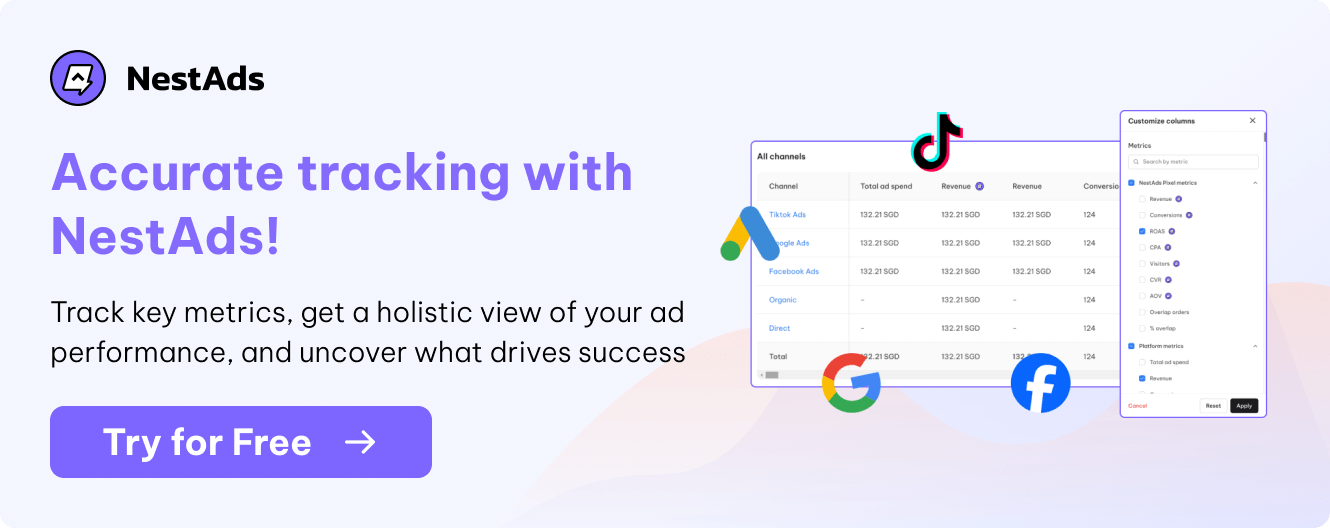
Scalability
Performance Max is designed to handle large-scale campaigns with minimal effort. It makes use of machine learning to do most tasks such as targeting, bidding, and ad creative automatically.
Moreover, automated bidding strategies in Performance Max help you optimize performance constantly, so you don’t need to adjust it over time. That’s particularly useful for businesses running multiple Search, Shopping, and Display campaigns, where managing budgets and ROAS targets can be overwhelming.
You can still scale your Standard Shopping campaign, but it requires quite more effort as it expands. Managing keywords, targeting, and bidding strategies becomes more complex and time-consuming as the scope of the campaign grows. Hence, you must actively monitor and update their strategies to maintain performance, which can be a real challenge for large-scale campaigns.
Recommendation: For scalability, Performance Max is a superior option as Google aims to combine eight different campaign types into this one campaign at the beginning. And it did a great job with its automated features, which save a whole lot of time and effort for businesses with multiple campaigns to manage and grow.
Targeting
Performance Max automatically targets users across multiple Google channels. It analyzes search history, interests, and demographic data to determine the most relevant placements. This is two sides of the same coin because it gives you broad reach, but you don’t know about its specific targeting criteria. So without data, it’s hard to say if your campaign is targeting the right audience or not.
Standard Shopping offers much more granular targeting options. You can specify keywords, product categories, locations, devices, and more. This makes greater precision in controlling who sees your ads and where the ads appear.
Recommendation: At its automation nature, Performance Max seems intelligent in this aspect, yet, you have to be sure it has enough data to be that “intelligent” and deliver your expected results. So if you have your own targeting strategy, Standard Shopping would be more helpful to make sure your ads reach the target audience effectively.
Budget
Performance Max takes a portfolio-based approach so there’s a shared budget across various products and campaigns within that portfolio. The platform automatically allocates your budget across multiple channels to maximize overall performance. Furthermore, it can make real-time budget adjustments based on your performance metrics. This aims to keep your spending proper while maintaining the effectiveness of your ads.
Standard Shopping has a more manual approach to budgeting. You can set daily or monthly budgets, yet, you have greater control over how these budgets are allocated among various targeting options, including keywords, products, and locations.
Recommendation: In terms of budget, Performance Max has excellent work with an automatic budget, which is super useful if you have to manage too many campaigns and don’t have much time. But of course, you grant Performance Max almost permission for budget allocation. That’s why Standard Shopping is still a good option for businesses with small budgets, as you can handle the budget optimization, and spend your money on the most promising areas.
Bidding
Performance Max mainly relies on automated bidding, using Google’s machine learning algorithms to determine the best bid for each auction. Strategies like Target CPA and Maximize Conversions are commonly used in PMax, where the algorithm automatically adjusts bids to achieve your target CPC or maximize the number of conversions within your budget.
Standard Shopping provides more flexibility with both manual and automated bidding options. You can select Manual CPC, where you set the maximum bid for each click to gain greater control over your budget. Alternatively, strategies like Enhanced CPC adjust bids automatically based on the likelihood of conversions.
Also, Standard Shopping supports Target CPA and Target ROAS, but its algorithm may not be as advanced or adaptable as PMax’s in optimizing bids based on real-time data.
Recommendation: We have to say that Performance Max has a more powerful bidding algorithm. It is constantly learning and adapting based on real-time data to analyze user behavior, search queries, ad performance, and market trends. Then, giving bidding decisions based on this large amount of information.
Tracking & reporting
Performance Max aggregates data from across Google channels to provide a comprehensive view of your campaign’s performance. You can access key Google Ads metrics such as clicks, impressions, conversions, and CPC. Besides, Performance Max utilizes the data-driven attribution model to help you track which touchpoints are most valuable in the customer journey.
The main keyword is “comprehensive”. What we mean to say is that you can not expect granular insights into how your ads are performing on each platform in Performance Max. Thus, this limitation can make it difficult for you to fully understand the campaign reach and assess your competitive position.
On the other hand, Standard Shopping offers more granular and detailed reporting. You can dive deep into specific aspects of your campaign, such as keyword performance, product-level insights, and location-based analysis. These insights are important to evaluate your potential to grow.
Recommendation: This is a crucial aspect to take into consideration when you need detailed data to optimize your campaign. And Standard Shopping does it better since it brings you valuable insights at a deeper level into how your campaign is performing.
Which to choose between Performance Max vs Standard Shopping?
Now it’s time to answer the question: Which to choose between Performance Max vs Standard Shopping?
If you’re a newbie and you want to run a new campaign, you should start with Standard Shopping. As I mentioned before about data dependency, the more data Performance Max has, the better it understands your user behavior and optimizes your campaign more effectively. Just except in the case that your products are super cheap or unique with very high demands in the market.
Furthermore, there are cases when you first use Performance Max, you may notice an initial performance boost, but then results decline. Nevertheless, you’re unable to identify the cause due to the limited data in reporting Performance Max. So, that makes Standard Shopping a good starting point for PPC newbies to build and grow ad campaigns gradually.
In another case, you have run your campaign for a long time and you observe that it has stable performance with a constant number of conversions each month. That’s when you can consider switching to Performance Max to scale your campaign.
A campaign with stable performance provides a strong foundation of data from which Performance Max can learn and optimize more efficiently. And one more thing, in case you forgot, Performance Max is one of Google’s latest platforms, so it’s obvious that they might allocate far more resources to its development than any other ad platform.
Ready to optimize your Google Ads effectively?
Now that we’ve covered everything you need to know about two types of Google Ads—PMax vs Shopping ads—it’s time to carefully consider which one fits your needs and resources. Crafting the right advertising strategy can make a big difference, but it’s also essential to look beyond just performance metrics like impressions. Focus on how your ads are actually contributing to your sales revenue. This is key for any e-commerce store aiming to get the most out of every dollar spent on ads.
It’s important to set up Google Ads conversion tracking so you can clearly see how your ads are driving sales. For an even more comprehensive view, we recommend using third-party analytics tools. This way, you can diversify your insights and understand how all your marketing channels are working together, rather than relying on the data from just one platform.
Consider using NestAds. We love it because of its advanced tracking tools that go beyond basic metrics. Take its customer journey feature, for example—it revolutionizes how you approach ad tracking. You can easily spot common paths that lead to purchases, allowing you to optimize key touchpoints in the customer journey. Plus, NestAds’ centralized data reports help you identify your top-performing channels, making it simpler to allocate your marketing budget and invest in the platforms that deliver the best results.
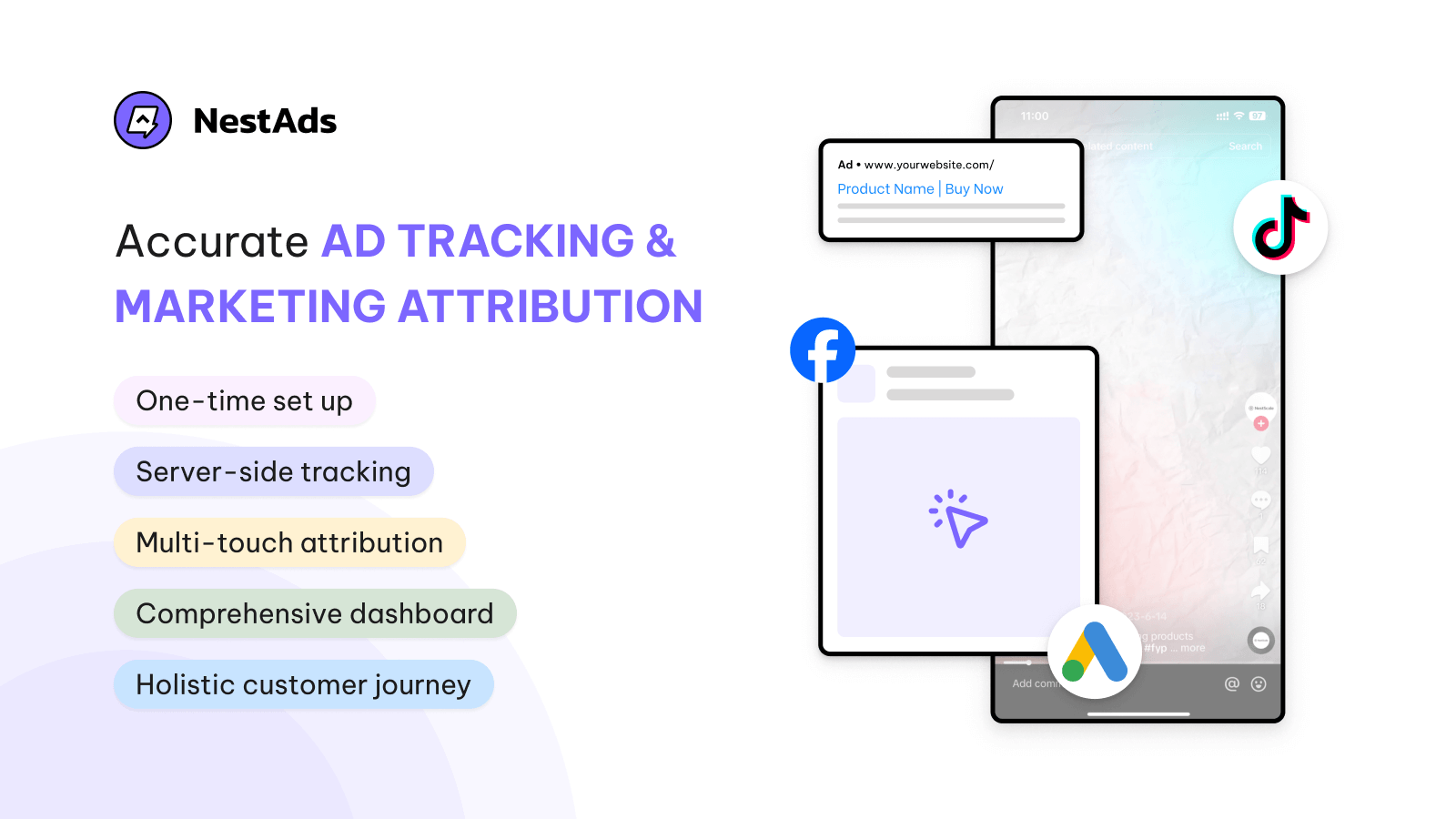
FAQs
Should I run Performance Max and Standard Shopping at the same time?
If they have different products and listing groups, there shouldn’t be an issue. You’d have two separate campaigns with distinct budgets and items. However, if the products and listings overlap, Performance Max would take priority over Standard Shopping.
Keep in mind that Performance Max doesn’t use keywords, so if the products are closely related to those in your other campaign, you may notice a drop in performance in Standard Shopping.
Actually, Standard Shopping is a good option for products that don’t perform well in Performance Max or have a low average order value (AOV). It also works for new brands with fewer conversions. On the other hand, Performance Max is ideal if you have the budget and can achieve at least 1-2 conversions per day, allowing Google to optimize better over time.
So if you want to run both at the same time, you can try it for different sets of products. For example:
- Performance Max for best-selling or higher-margin products.
- Standard Shopping for other products.
What should I do when I switch from Standard Shopping to Performance Max but my campaign is not doing well?
We suggest running a separate Standard Shopping campaign with your underperforming products. Since you can’t be sure of the root causes for suboptimal performance in Performance Max, you can more easily identify them in Standard Shopping.
This is also a good way for A/B testing. It helps you compare their performance directly and determine which approach is most effective for your underperforming products.
Besides, let’s say you didn’t have enough conversion data but you’re running Performance Max. You can switch back to Standard Shopping so that it will provide additional insights and data points to inform your future optimization efforts, especially when it’s “mature” enough to put in Performance Max.
What is a feed-only Performance Max campaign and should I use it?
A Feed-Only Performance Max campaign is a type of PMax setup that exclusively uses your Google Merchant Center feed, without including extra assets such as headlines, images, or descriptions. It enables you to focus solely on the product feed for your campaign.
Using a Performance Max feed-only campaign is a good option when you don’t have high-quality images and videos to add to your ads. It allows you to run ad campaigns effectively by focusing on the products in your existing data feed.
This is especially helpful as it can take advantage of the priority that Performance Max has. So, your feed only campaign tends to generate more traffic compared to the Standard Shopping campaign.




































